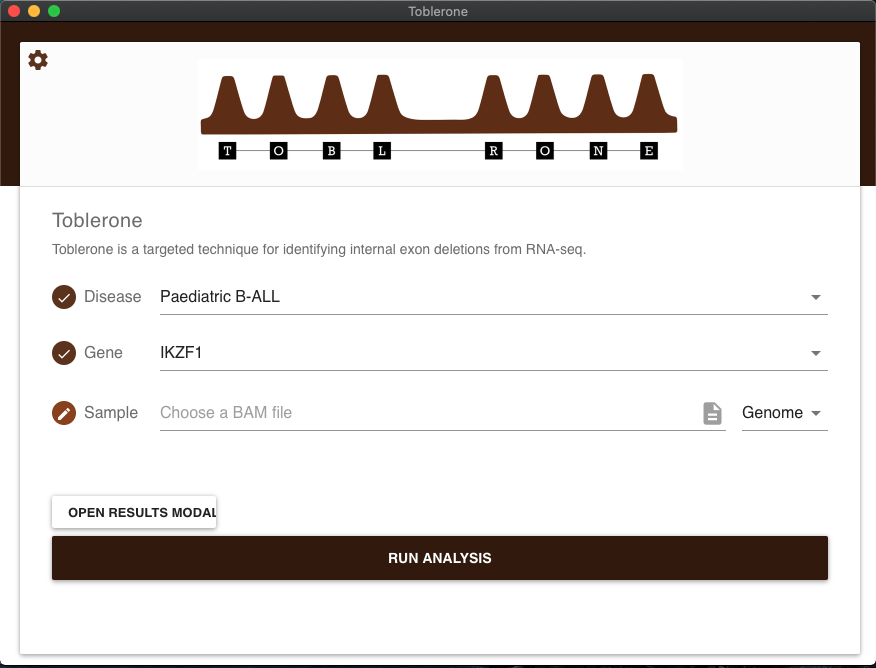Toblerone is a method for detecting exon deltions in RNA-seq data. You'll notice in the logo that an e(xon) is missing!
It is currently in development, extending the methods described here for acute lymphoblastic leukemia (ALL) focal deletions in IKAROS family zinc finger 1 (IKZF1) : https://github.com/Oshlack/ALL-RNAseq-utility-paper. Toblerone looks for internal exon (not first or last) deletions.
Toblerone consists of two key concepts: a specialised transcriptome and a modified pseudoalignment algorithm
A desktop app is also available for single sample analysis.
The psuedaligner core is currently called tinyt and can be run in standalone mode form the command line, or is inclued in the Toblerone app (see below).
tinyt
Usage:
tinyt index [--num-threads=<n>] -i <index> <ref-fasta>
tinyt map [--num-threads=<n>] [--read-length=<r>][--trim-size=<t>] [--skip-trim] [--output=<file>] -i <index> <reads-fastq> [<reads-pair-fastq>]
tinyt -h | --help | -v | --version
Options:
-n --num-threads N Number of worker threads [default: 2]
-t --trim-size T Size of base pairs to trim when checking unique read matches [default: 2]
-s --skip-trim Skip the trim read check for unqiue read matches
-r --read-length R Provide read length for depth estimation
-o --output FILE Output results to file instead of stdout
-h --help Show this screen.
-v --version Show version.
For a candidate gene, e.g. IKZF1, we take the the canonical transcript and generate a specialized transcriptome reference that consists of the original transcript plus deletion transcripts. Deletion transcripts consist of combinations of continuous exon deletion, excluding edge exons (first and last) exons. For N exons, (N-1 choose 2) additional deletion transcripts created.
graph TD;
A[\input gene defintion/]-->B;
B[generate deletion definitions]-->D;
C[\input genome/]-->D[create deletion transcripts];
D-->E[index];
For the gene(s) of interest, a canonical transcript should be provided which is the full length in order for the maximum number of exon deletions to be captured. Currently only BED12 file format is accepted.
python scripts/make_bedfiles.py input.BED12 temp_output_dir
Merge all the generated BED files into one:
find temp_output_dir -name "*.bed" -type f -exec cat {} + > combined.BED12
The canonical transcripts corresponding to the BED12 files must also be provided, and then bedtools can be used to generate the toblerone_transcriptome:
bedtools getfasta -fi input_genome -bed combined.BED12 -split -name > toblerone_transcriptome
The toblerone_transcriptome can now be indexed for further mapping.
The index subcommand is run, using a convention of a .tidx for the toblerone index output.
tinyt index -i toblerone_transcriptome.tidx toblerone_transcriptome
The extension .tidx is a convention meant to indicate 'toblerone index', but any filename can be used.
Reads can now be mapped and the counts, proportions and scaled proportions of deletions in a sample can now be calculated:
graph TD;
A[\toblerone_transcriptome/]-->C;
B[\input RNA-seq reads/]-->C[tinyt map];
C-->E[Deletion summary csv];
tinyt map -i toblerone_transcriptome.tidx <reads>
and stdout or a named output file will provide the per deletion trasncript information:
Gene, Deletion,Count,Total, GeneLength, ReadLength, Scale Factor,Proportion,Scaled Proportion
This pseudoalignment implementation is based on the 10X Genomics Pseudoaligner code (https://github.com/10XGenomics/rust-pseudoaligner/), which itself draws on the concepts from Kalisto(), Salmon() and others. It is released under the MIT license in line with the template source. It is heavily modified for a Toblerone index, and not intended for general transcriptomes.
TODO
TBC
- Move transcriptome generation script into core
- Rebuild original
bpipepipeline for transcript creation

